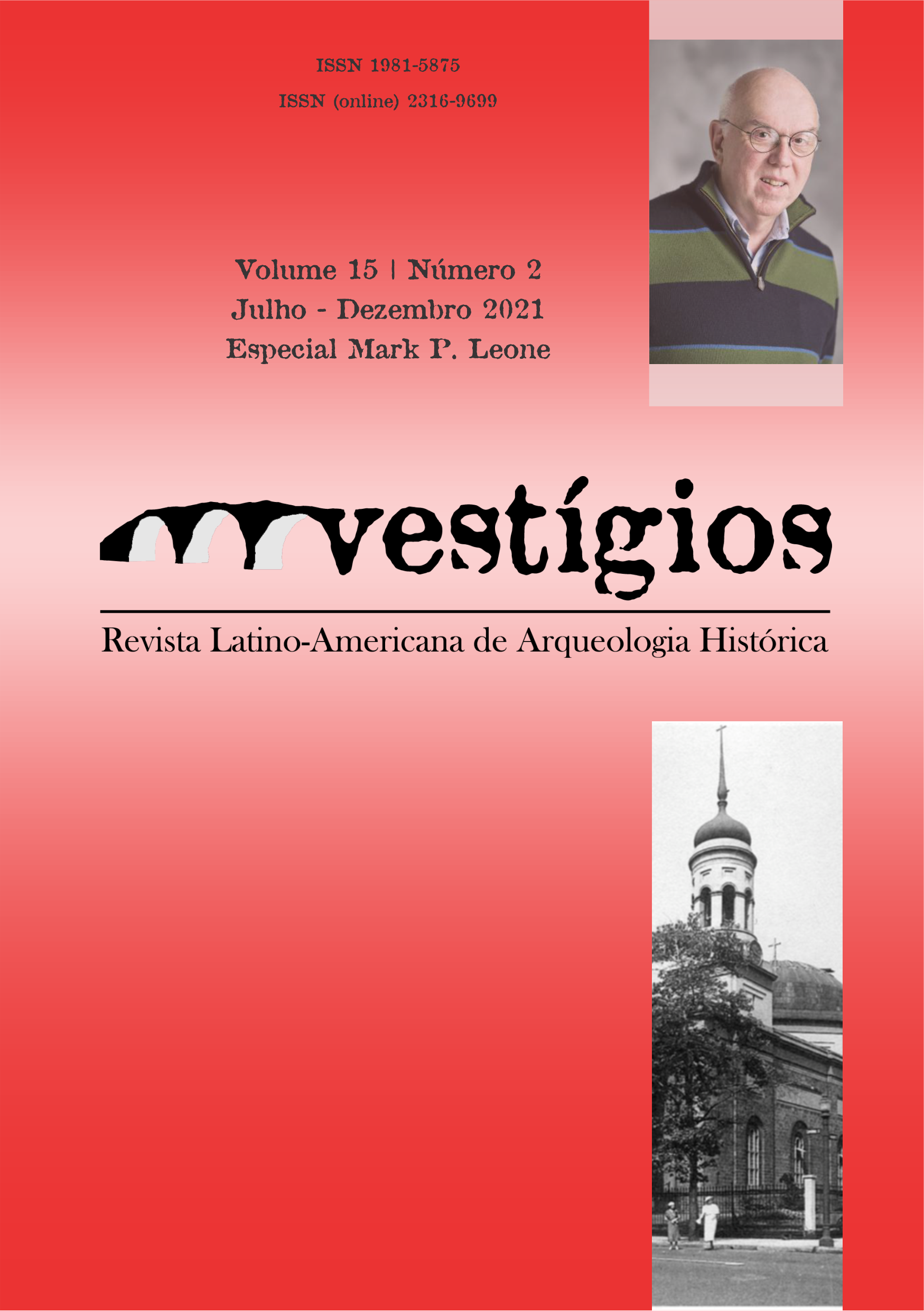Interpretando la ideología en la Arqueología Histórica
usando las reglas de la perspectiva en el jardín de William Paca en Annápolis, Maryland
DOI:
https://doi.org/10.31239/vtg.v15i2.35404Palabras clave:
Arqueología Histórica, Ideologia, Annapolis, MarylandResumen
Este capítulo se centra en la manera en que las representaciones ideológicamente modeladas sirven para naturalizar el carácter arbitrario del orden social. En él se muestra cómo la construcción de un jardín del siglo dieciocho empleaba una serie de medios para este fin. A través del uso de citas clásicas y del desarrollo de una determinada concepción de precedentes con asociaciones jurídicas, el jardín representa una determinada racionalización del tiempo, lo que además niega su propia naturaleza transitoria. Su geometría y óptica, ejemplificadas en su uso de la perspectiva, sirven a una racionalización controlada del espacio. En conjunto, el jardín no sólo funciona como una representación, sino que además opera como un instrumento para la observación atenta y experimental y de control de la naturaleza. El jardín, así como la forma segmentada y ordenada de la arquitectura Georgiana, se pueden relacionar con las contradicciones de una sociedad que proclamaba la libertad y la independencia, al tiempo que mantenía un sistema de esclavitud. El jardín salvaje deliberadamente planeado ejemplifica especialmente dichas contradicciones.
Referencias
Althusser, L. (1971). Ideology and Ideological State Apparatuses. In Lenin and Philosophy, pp. 127-86, Monthly Review Press, New York
Breen, T.H. (ed.) (1976). Shaping Southern Society, Oxford University Press, New York.
Charles Carroll Letterbook (1760). September. Hall of Records, Annapolis, Maryland.
Cohen, P. C. (1981). Statistics and the State: Changing Social Thought and the Emergence of a Quantitative Mentality in America, 1790-1820, William and Mary Quarterly, Third Series, 38 (1), p. 35-55.
Deetz, J. F. (1977). In Small Things Forgotten, Doubleday, Garden City, New Jersey.
Farish, H. D. (ed.) (1943). Journal and Letters of Philip Vickers Fithian, 1773-1774, Plantation Tutor of the Old Dominion, Colonial Williamsburg Inc., Williamsburg, Virginia.
Glassie, H. (1975). Folk Housing in Middle Virginia, University of Tennessee Press, Knoxville,
Greene, Jack P. (ed.) (1965). The Diary of Colonel Landon Carter of Sabine Hall, 1752-1778. vol. 1, The University of Virginia Press, Charlottesville, Virginia.
Gurevich, A. J. (1976). Time As a Problem of Cultural History'. In Ricoeur, P. (ed.), Cultures and Time, p. 229-45, The Unesco Press, Paris.
Isaac, R. (1982a). The Transformation of Virginia 1740-1790, University of North Carolina Press, Chapel Hill.
Isaac, R. (1982b). Terrain, Landscape, Architecture, and Furnishings: Social Space and Control in Old Viiginia. Paper read at the twenty- second annual meeting of the Northeastern Anthropological Association, Princeton, N.J.
Klapthor, M. B., & Morrison, H. A. (1982). G. Washington, A Figure Upon the Stage, Smithsonian Institut Press, Washington, D.C.
Langley, B. (1726). New Principles of Gardening, Bettsworth and Batley, London
Le Blond, A. (1728). The Theory and Practice of Gardening, Bernard Lintot, London
Levi-Strauss, C. (1963). Split Representation in the Art of Asia and America. In Structural Anthropology, p. 245-68. Basic Books, New York
Little, J. G., II (1967-8). Re: Archaeological Research on Paca Garden. November 8,1967, May 24,1968. Letters on file, William Paca Garden Visitors' Center, Annapolis, Maryland.
Lukacs, G. (1971). Reification and the Consciousness of the Proletariat. In History and Class Consciousness, M.I.T. Press, Cambridge, Mass.
Miller, P. (1733). The Gardener's Dictionary. Printed for the author. London.
Okoye, F. N. (1980). Chattel Slavery as the Nightmare of the American Revolutionaries'. William and Mary Quarterly: Third Series, 37: l, p. 3-28.
Orr, K. G., & Orr, R. G. (1975). The Archaeological Situation at the William Paca Garden, Annapolis, Maryland: The Spring House and the Presumed Pavilion House Site. April', Typescript on file, William Paca Garden Visitors' Center, Annapolis, Maryland.
Papenfuse, E. C. (1975). In Pursuit of Profit: The Annapolis Mechants in the Era of the American Revolution, 1763-1805, Johns Hopkins University Press, Baltimore, Maryland.
Powell, B. B. (1966). Archaeological Investigation of the Paca House Garden, Annapolis, Maryland. November 16, 1966', Typescript on file, William Paca Garden Visitors' Center, Annapolis, Maryland.
Rowe, J. H. (1965). The Renaissance Foundations of Anthropology'. American Anthropologist, 67, p. 1-20.
Shanks, M., & Tilley, C. (1982). Ideology, Symbolic Power and Ritual Communication: A Reinterpretation of Neolithic Mortuary Practices. In Hodder, I. (ed.), Symbolic and Structural Archaeology, Cambridge University Press.
South, S. (1967). The Paca House, Annapolis, Maryland. Unpublished ms., Historic Annapolis, Inc., Annapolis, Maryland.
Stiverson, G. A., & Jacobsen, P. R. (1976). William Paca, A Biography. Maryland Historical Society, Baltimore, Md.
Tate, T. W., & Ammerman, D. L. (1979). The Chesapeake in the Seventeenth Century. Norton and Co., New York.
Thorpe, I. J. (1981). Anthropological Orientations on Astronomy in Complex Societies. Paper read at the Third Theoretical Archaeology Conference, Reading, U.K.
Woodfin, M. H. (ed). (1942). Another Secret Diary of William Byrd of Westover, 1739-1741, The Dietz Press, Richmond, Virginia.
Wright, L. B., &Tingling, M. (eds.) (1963). The Great American Gentleman William Byrd of Westover in Virginia. His Secret Diary for the Years 1709-1712, Putnam's Sons, New York, G.P.
Yentsch, A. E. (1982). Letter on Spring House Excavations, William Paca Garden. 15 March, on file, William Paca Garden Visitors' Centre, Annapolis, Maryland.
Descargas
Publicado
Número
Sección
Licencia
Derechos de autor 2021 Mark P. Leone; Pedro Fermín Maguire

Esta obra está bajo una licencia internacional Creative Commons Atribución-NoComercial 4.0.

O trabalho Vestígios - Revista Latino-Americana de Arqueologia Histórica de https://periodicos.ufmg.br/index.php/vestigios/index está licenciado com uma Licença Creative Commons - Atribuição-NãoComercial 4.0 Internacional.
Baseado no trabalho disponível em https://periodicos.ufmg.br/index.php/vestigios/index.
Podem estar disponíveis autorizações adicionais às concedidas no âmbito desta licença em https://periodicos.ufmg.br/index.php/vestigios/index.


